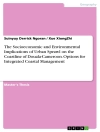The book contributes to understanding the pattern of strain release and the level of seismic hazard imposed by large-great earthquakes in the frontal fold-thrust belts of Kumaun and Garhwal regions of Uttarakhand. The motivation for active fault studies and their characterization have been emphasized. The book presents the compilation of knowledge garnered in multidisciplinary or proxy studies involved in the understanding of seismic hazard in general and Kumaun–Garhwal Himalaya regions in particular with lucid new maps draped on modern Cartosat or SRTM DEM data. It also discusses satellite image calibration, active faults identifications, and map productions with flowchart. The book discusses window-wise active fault elements with attributes together with the tectonic geomorphic map. It also includes active fault scarp with topographic profile along with field photographs. Finally, it reviews all existing seismotectonic models of the Himalaya, its earthquake hazard, and its vulnerability, specifically for Kumaun and Garhwal regions.
Mục lục
Chapter 1. Introduction.- Chapter 2. Mapping of Active Faults.- Chapter 3. Active Faults in Kumaun and Garhwal Himalaya.- Chapter 4. Concluding Comments and Structure of Online Interactive Active Fault Database.
Giới thiệu về tác giả
Dr. R. Jayangondaperumal is a Senior Scientist in the Wadia Institute of Himalayan Geology, Dehradun. He has been working in research projects related to structural geology, earthquake geology, and tectonics for over one and a half decade. Dr. Perumal and his team have excavated about 25 trenches for paleoseismological study along the Himalayan frontal zone. He has significantly contributed in understanding the relationship between strain accumulation and release in context of mechanics of earthquakes and mountain building processes so as to quantify the seismic hazard associated with the Himalayan continental collision. He has also carried out seismic hazard assessment for the Subansiri hydro-power project in the NE Himalaya. He has published over 46 papers, and contributed two book chapters and one Indian Patent. Currently, he along with his large team of students carrying out national level research projects on earthquake geology in NE and NW Himalaya.
Dr. Vikram C. Thakur is M.Sc. Panjab, and Ph.D. DIC London University. He joined the Wadia Institute of Himalayan Geology in 1972. He has worked extensively in unravelling the regional framework and tectonics of the remote regions of Ladakh, Zanskar, Chamba, Garhwal, Kumaun, and Arunachal. On his retirement as Director of the Institute he was awarded Emeritus Scientist of the CSIR, since then he has been working in several research projects on active tectonics of the Himalayan frontal zone. He has published more about 130 papers and authored a book “Geology of Western Himalaya”, Pergamon Press, Oxford. He is a fellow of the Indian Academy of Sciences (1991) and recipient of the National Mineral Award (1984).
Dr. V. Joevivek is a Professor and Dean (Research) at Akshaya College of Engineering and Technology, Coimbatore. His field of specialisation is remote sensing and physical geography. He has published over 15 papers, one book chapter and contributed two Indian Patents. This book is part of his research work carried out at the WIHG under Institutional flag-ship project.
Ms. Priyanka Singh Rao is a Geologist working in Geological Survey of India and also pursuing her Ph D degree in “Surface Rupture Investigations of the 1950-Meisoseismal Zone of Assam Earthquake along Himalayan Foothill Zone, Arunachal Himalaya”. She discovered surface faulting of 1950 Assam earthquake along the eastern Himalayan frontal thrust.
Prof. Anil K Gupta has been a faculty at the Indian Institute of Technology Kharagpur, Kharagpur. Presently, he is the Director of the Wadia Institute of Himalayan Geology at Dehradun. Prof. Gupta has extensively worked to study paleoceanographic and paleoclimatic evolution of the Indian Ocean with special reference to the understanding of short- and long-term changes in the Asian/Indian monsoons and their connections with the Himalayan uplift. Prof. Gupta’s research has been widely cited and recognized through several prestigious awards including the Indian Science Congress Association Young Scientist Award 1990, the National Mineral Award (2000) and the TWAS Prize in Earth Sciences (2010). He is the fellow of several science academies (INSA, NASI, IASc, TWAS) and is the recipient of J C Bose fellowship.












